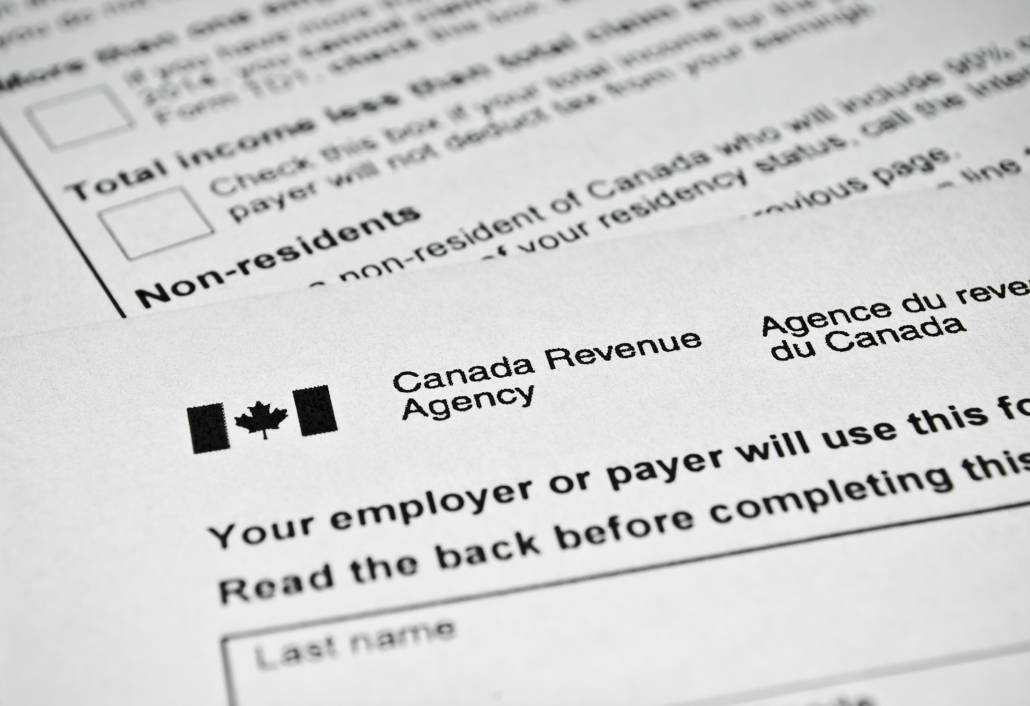October tax news: Moving as a tax expense, having CRA penalties waived–and more

MOVING EXPENSES—AN OVERLOOKED TAX EXPENSE?
Moving expenses can generate a vast array of deductible items that one can use to offset against new employment location income. People often will neglect a portion of moving expense claims, simply because they are unaware of the long list that constitutes possible moving expenses. This is a very useful deduction to help Canadian taxpayers settle into new jobs or educational training opportunities. At the heart of the issue are three topics:
- Who can claim moving expenses in the first place
- Whether one should claim (or employer should pay for the expenses)
- What types of moving expenses can be claimed
- Who can claim?
Basic eligibility: new home must be 40 km closer by the shortest public route to your new work or place of study.
A self-employed individual, student or an employee can all claim moving expenses. The form to fill here is called T1-M, and it is a straight deduction against one’s income.
Students: have to be full time, attending a program at a post-secondary level, and taking at least 60% of the usual course load. A point to note is that students can only deduct these expenses from the parts of their scholarships/bursaries and grants that are required to be included in their income. Since most scholarships are exempt, many students find that they cannot use the deduction.
However, a crucial point to note is that co-operative work or summer employment is also eligible for this moving deduction expense. Many students are not aware, and therefore do not use the moving expense deduction against this employment income!
- Should employer claim or employee claim?
If an employer is paying for moving expenses, they can usually deduct all moving expenses for the employee as payroll expenses. The employee in this case would not be able to claim these expenses. A topic for debate here is whether employers and employees should opt for a moving allowance or a moving reimbursement claim. An allowance is a fixed amount, usually set ahead of time. A reimbursement is based on receipts and reimburses actual expenses incurred.
Moving allowance:
Usually, the entire moving allowance is included in employee’s income and is taxable at the normal marginal income tax rate applicable. Employees can still claim moving expenses deduction on their tax forms, but they now have an income addition as well. For employers, giving a moving allowance helps cap their expense liability for moving expenses, and is an easier administrative process than hiring administrative staff to collect, review and scrutinize employee moving-expense forms. However, a moving allowance of up to $650 for incidental employee moving expenses is non-taxable if the employee certifies having spent at least that much (per CRA Guide T4130), and does not deduct the expenses.
Employers reimbursing employee for moving expenses:
In this case, employees cannot claim moving expenses, unless an employer does not cover specific moving expenses. The employer may have a limit on moving expense reimbursement, to keep employee moving costs down. For employees, it’s sometimes easier as well, because they don’t have to keep their moving expense backup documents for tax time, and they do not have to claim moving expenses on their tax forms, as Form T1-M can sometimes be a tricky document to complete.
For employees, if the employer gives the option of getting a reimbursement or a moving allowance, check how generous the moving allowance is. If there is a generous moving expense package, and it’s not cumbersome to keep relevant moving expense forms, then for an employee there is a benefit to, receiving the moving allowance, claiming the moving deduction on Form T1-M, and pocketing any additional allowance, net of the related tax.
- What types of expenses one can claim:
The moving expenses that can be claimed are an extremely broad category!
- Travel expenses such as vehicle costs, meals, accommodation to move an individual and their household members to the new home.
- Temporary living expenses for a maximum of 15 days for meals and interim lodging near the old and new home for household members.
Important note: people sometimes forget that temporary lodging near the old home can be claimed. Take advantage of this!
- Transportation and storage costs such as packers, hauling and movers, storage and insurance for household items, which can include items like boats and trailers.
- Cost of cancelling lease, except any rental payments before cancellation of your lease.
- Small costs related to moving, such as changing addresses on legal documents, drivers’ licenses, non-commercial vehicle permits (does not include insurance) and utility hookups and disconnections.
- Costs to maintain old home while it is vacant up to a maximum of $5,000 after moving, and during a period where reasonable efforts were made to sell the old home. This would include interest, property taxes, insurance premiums and cost of utilities. However, if the old home is rented out, these costs cannot be claimed (though they could qualify as rental expense deduction).
- Costs of selling old home, including advertising, legal/notary fees, mortgage penalty, and real estate commission (including the GST/HST on these fees).
- The cost of buying your new home includes legal or notary fees you paid to buy your new home, as well as any taxes paid (other than GST/HST) for the transfer or registration of title to the new home.
Detailed vs Simplified method—for meals and mileage
For meals and mileage, there are two methods to claim expenses. Under the simplified method, CRA provides a flat rate that can be used. The 2023 rates will not be announced until early 2024, but for 2022 it is $23 per meal (for 3 meals a day) i.e. $69/day per person.
Under the detailed method, all receipts must be kept available for audit by CRA. This involves meticulously calculating all meals and gas mileage expenses, and the total can then be claimed. This can be quite cumbersome and prone to error. Note: The vast majority of tax claimants use the simplified method.
For mileage, under the detailed method, one has to keep all gas receipts as backup. But with the simplified method, based on the distance between the two locations, you can claim a fixed number of cents per km, varying by province and based on where your travel begins. The number of cents per km for 2022, which varies from 55 to 66.5 cents, can be found on the CRA website. For example, for a move beginning in Ontario in 2022, it was 61.5 cents.
Example:
Ayesha is a single person, and switched jobs in 2022, and she moved 250km closer to work from her previous home in Ontario to her new abode. Her 2022 new employment income was $30,000. She was given a moving allowance of $10,000 by her new employer, included in her 2022 income.
These expenses cannot be deducted:
Ayesha incurred a loss of $10,000 when selling her old home; $2,000 in travel expenses in a house-hunting trip to scout her new home location. She also spent $1,000 to make her old home appear more saleable. None of these expenses can be claimed.
Deductible expenses that can be claimed:
Ayesha spent $1,000 on hauler charges to move her household items. She also stayed for a day in temporary lodging, until her new home was ready. The hotel charge was $200. Using the simplified flat-rate meal and mileage claim, her meal expenses claimed for 2 days of travelling to get to her new home are $69 x 2 = $138. Her mileage expense is 250km x 61.5 cents/km = $153.75. She can also deduct interest, property taxes, heating and insurance premiums of $5,000 incurred to maintain the old home while it was vacant and not yet sold. She also spent $10,000 on advertising and incurring real estate commissions on selling her old home. Another $1,000 arose from incidental costs such as new driving licenses and legal/notary fees to buy the new home.
The total expenses Ayesha claimed on her 2022 tax return were $17,491.75 − leading to significant savings of tax!

GETTING CRA TO WAIVE OR CANCEL PENALTIES AND INTEREST
This is a very topical issue, and its exact workings are mysterious to many. Many people are not even aware of this option. CRA, under the provisions of the Income Tax Act that are usually referred to as “Taxpayer Relief”, has the discretion to waive any or all amount of penalties and interest. However, this comes with conditions.
Note that outstanding taxes cannot be waived. CRA has discretion to eliminate penalties and interest, but not tax.
A taxpayer or their authorized representative can make a request to cancel penalties using CRA My Account online, or by filling out Form RC4288 Request for Taxpayer Relief – Cancel or Waive Penalties and Interest, and sending it either online or by mail to the CRA. The key is to demonstrate extraordinary circumstances that were beyond the control of the taxpayer.
These circumstances include the following:
- CRA error or delay which resulted in confusion or delay in complying with one’s tax obligations.
- Natural or human-made disasters – for example, a fire that destroyed records, delaying the ability to file tax returns on time.
- Death, accident or serious illness of the taxpayer, or, for a company, of a key shareholder or employee.
- Civil disturbance
- Financial hardship
- Any other valid reason
With all of these, you need to be able to show the connection between the event and the inability to file or pay on time. Simply being sick is not enough; for example, you would need to show that you were sick and unable to act during the time you were required to act. And if you were only sick for a short time, then the CRA might waive interest for only that short time.
Laziness or forgetfulness is not a valid excuse. While this relief measure is for extraordinary circumstances, it is sometimes worth attempting this form even if the reason may not pass the litmus test of extraordinary circumstances, because it is at the CRA’s discretion to grant such a request.
Important note: CRA can give a relief for up to 10 years of interest and penalties from the year of the request. For example, if the request is made in 2023, only interest accrued during 2014 and later years can be cancelled.
CRA TERMINATING 120 EMPLOYEES FOR CERB VIOLATIONS—AGENCY EMPLOYEES DO MAKE MISTAKES, OPTIONS EXIST, IF AGGRIEVED, DO CONSULT
News outlets have announced that CRA fired 120 employees for inappropriately claiming Canada Emergency Response Benefit (CERB) during the COVID-19 pandemic. This was their official statement:
“The CRA takes any form of wrongdoing very seriously and is strongly committed to protecting the integrity of Canada’s tax and benefit systems and demonstrating to Canadians that [we are] a trusted and fair organization… When misconduct is identified, we ensure that the appropriate actions are taken to address it.”
So how does this relate to the reader? These employees were fired for falsifying documents/forms claiming CERB benefits meant for individuals whose employment and earnings were impacted by COVID-19. CRA has a reputation for strict compliance. Notwithstanding its reputation, gross ethical violations were occurring in the agency. It proves that employees at the agency are human and can engage in dubious transactions.
CRA call center employees often give taxpayers inaccurate advice. CRA audits also often involve mistakes. CRA’s word is not gospel. If a taxpayer feels they were treated unfairly, or their situation is misunderstood, they do have the option of appeal, as CRA employees are clearly fallible.
In these cases, a consultation with an accounting firm or specialized income tax law firm is well worth your time. You need to understand what the law is before appealing. If you have a worthwhile case, you can file a Notice of Objection to appeal within the CRA. If you are then turned down but still believe you are right, you can appeal to the Tax Court of Canada. The Court does step in to reverse CRA assessments that are found to be legally incorrect. The court case below is a very recent example of Tax Court finding a judgement in favour of the taxpayer.

AROUND THE COURTS
Preston v. The King is an interesting case where the appellant scored a victory against CRA. This is a case involving business expense deduction, where the appellant won despite having a non-arm’s length relationship with his key business customer!
Case Facts – Business Expense Deductibility
Randall Preston, a seasoned business entrepreneur, created a business of using his business management and contract negotiation skills to further his daughter’s musical career. The daughter was seriously pursuing this career, and Mr. Preston helped her meet with prospective customers, and record an album. At issue were significant losses emanating from business expenses incurred by Mr. Preston in 2017. The daughter and Mr. Preston were able to generate very marginal revenue from these activities. CRA disallowed the business expenses. There was barely any revenue in the venture, and large expenses, including $52,046 claimed for 2017.
What is interesting about this case is that there was a personal element (the client was the appellant’s daughter) which complicated things. Additional questions must be answered to prove the commercial nature of the arrangement if it is a non-arm’s length transaction. Yet despite this additional difficulty, the appellant’s appeal was successful.
Legal Framework
For a business carried on by an individual, if expenses exceed revenue, a loss can be claimed against other sources of income. The litmus test here is whether the income source passes the two-step approach set out by the Supreme Court of Canada:
- Is the activity in question undertaken in pursuit of profit, or is it a personal endeavor? Does the taxpayer intend to carry activity for profit and is there objective evidence to support their intentions?
- If the activity is not a personal endeavor, is the source of income a business or property?
If the activity is commercial, contains no hobby element and evidence is consistent with the view that it’s a profit-seeking venture, then it passes the test. Also, if the activity has elements of a personal hobby, that doesn’t necessarily mean losses cannot be claimed. The question to answer is whether the activity is being carried on in a sufficiently commercial manner.
The determination of “sufficiently commercial manner” includes a list of objective factors such as (a) profit/loss experience in past years, (b) the taxpayer’s training, (c) the taxpayer’s intended course of action, and (d) the capability of the activity to show a profit.
Analysis of case facts
In this case, there was a definite element of personal endeavor because the artist client was the taxpayer’s daughter. However, that didn’t mean it was not a commercial endeavor. Mr. Preston was able to show significant objective evidence to support his arguments of carrying on a commercial endeavor.
Objective facts to support appeal: The key here is that on a substantive level, the taxpayer took good faith steps to seek a profit in the business venture.
- The daughter had a number of talent competitions and received promising feedback from a judge in one of the musical talent contests, who helped her produce an album. There was a good faith attempt to find contracts.
- Albums were produced for the purpose of earning money from the musical venture. There was an objective attempt to try to earn income.
- Mr. Preston hired a music industry accountant to do his tax returns and help him understand the music industry from a financial lens. He was serious about setting up a business.
- The appellant also displayed intent of carrying on a commercial business by building up a network of industry contacts which led to a recording in Nashville (the music mecca) in 2017.
Conclusion
Mr. Preston proved based on objective evidence that his activities were of a commercial nature and although there was a personal element, he was genuinely seeking a profit. Therefore, his appeal of 2017 was allowed by the Tax Court, and he was allowed to deduct over $50,000 in losses, despite no material income generated from the business.
***
This letter summarizes recent tax developments and tax planning opportunities; however, we recommend that you consult with an expert before embarking on any of the suggestions contained in this letter, which are appropriate to your own specific requirements. For assistance with your tax planning and accounting needs, contact a member of our team.


